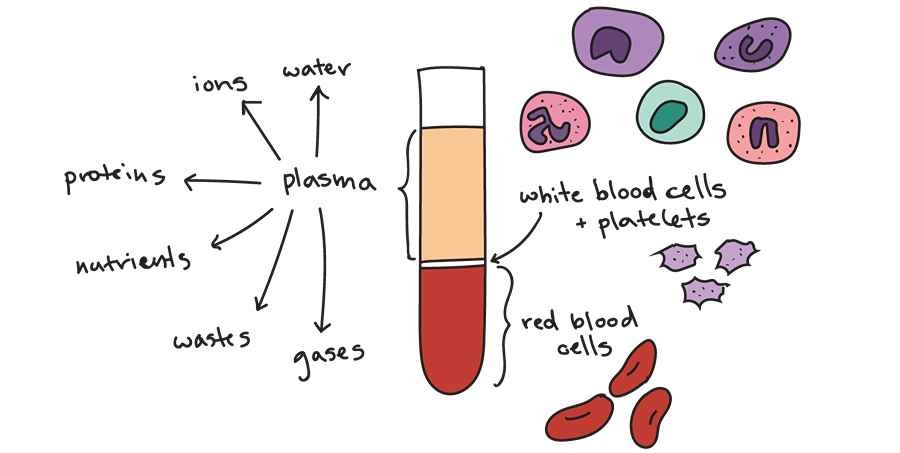A full blood count (FBC), also known as a complete blood count (CBC), is one of many blood tests used to evaluate your general wellbeing and detect a wide range of disorders like anemia, infection, bleeding disorders, leukemia, and so on.
Components of Blood

A full blood count test measures the components and features of your blood, including:
- Haematocrit: also known as packed cell volume (PCV) the proportion of red blood cells in the plasma, the liquid part of the blood.
- White blood cells: are also known as the soldiers of the body, as they fight infections.
- Platelets: help the blood to clot. This applies to helping stop cuts and wounds from bleeding.
- Red blood cells: this is the portion of blood that carries oxygen in the body.
- Haemoglobin concentration: hemoglobin is the oxygen-carrying component of your blood found in the red blood cells.
Abnormal increases or decreases of these components in your full blood count may indicate that you have an underlying medical condition that requires further testing and evaluation.
Reasons your doctor might request an FBC
A full blood count is done for a variety of reasons, which include:
- Routine medical checkup: Your doctor could recommend a full blood count as part of a routine medical examination to monitor your general health.
- To diagnose a condition: Your doctor may suggest a full blood count if you’re experiencing weakness, fatigue, fever, or bleeding. A full blood count could help diagnose the cause of your symptoms.
- To monitor your condition: If you’ve been diagnosed with a blood disorder that affects your blood cell counts, your doctor may use your full blood count to monitor your condition.
- To monitor medical treatment: A full blood count may be used to monitor your health if you’re taking medications that may affect your blood cell count.
What to do before the test
If you are being referred for a full blood count only, you do not need any special instructions.
You can eat and drink normally before the test, which can be done at any time of the day; however, if you have to do it alongside other tests (like glucose measurement tests), you would need to fast as instructed and probably carry out the test in the morning.
Your doctor would, however, inform you of any additional instructions you need to keep before the test.
How is the test done?
You would be asked to sit upright in a chair and place your arm, palm up, on an elevated armrest.
The clinician will then tie a tourniquet around the top of your arm to temporarily restrict the blood flow from your arm back to your heart.
This will make the vein inside your elbow “pop out,” making it easier to find.
The area where the needle will be inserted is wiped with a sterile alcohol wipe to reduce any risk of infection.
A needle is inserted into the vein, and a small amount of blood is drawn into the attached syringe before being placed in a vial or bottle.
If the sight of blood makes you uncomfortable, it is best to look away.
There is usually minimal pain, but that would only last a little while.
After the procedure, the clinician will press a small wad of cotton wool on the entry point to stop the flow of blood.
Sometimes a little bruise is left on this spot, but this is nothing to worry about.
You ought not to experience any other side effects; if you do, however, kindly inform your healthcare provider.
The blood sample is then sent to a laboratory for analysis.
What to do after the test
The main part is over now.
So you can return to your daily routine or wait for the result if asked to wait.
Possible results of the test
The following are normal full blood count results for an adult:
| Males | Females | Males and Females | ||
| Red cells | 4.5–6.5 trillion cells/L (4.5–6.5 million cells/mcL) |
3.9–5.6 trillion cells/L (3.9–5.6 million cells/mcL) |
||
| Haematocrit/PCV | 40-52% | 36-48% | ||
| White cells | 4–11 billion cells/L (4,000 to 11,000 cells/mcL) |
|||
| Haemoglobin | 13.5-17.5g/dL | 11.5-15.5g/dL | ||
| Platelets | 150,000-400,000 cells/mcL | |||
|
L = liter, mcL = microliter, dL = deciliter |
||||
*Table of Values Gotten From Essential Hematology (Essential Hematology by Hoffbrand, Victor, Moss, Paul, 6th Edition.)
Interpretation of the test result
First, it should be noted that the values above are what are found in textbooks for developed cultures.
Values for Africans and blacks tend to vary and are still undergoing research; hence, you should consult your doctor for further interpretation of the results.
However, results in the following areas above or below the normal ranges on a complete blood count may indicate a problem:
- Red blood cell count, hemoglobin, and hematocrit: The results of your red blood cell count, hemoglobin, and hematocrit/PCV are all related because they all measure various aspects of the red blood cells. If the measures in these three areas are lower than normal, then you have anemia, which usually presents as fatigue and weakness. Anemia has various causes, like tapeworm infestation, a lack of certain vitamins and minerals in your diet, blood loss, or other underlying conditions. If these measures are higher than normal values, then you most likely have erythrocytosis, which could point to an underlying medical condition, such as polycythemia vera.
- White blood cell count: A low white blood cell count called leukopenia may be caused by an autoimmune disorder that destroys white blood cells, bone marrow problems, some infections, cancer, or even certain drugs. If your white blood cell count is higher than normal, it could indicate an infection, a bone marrow disease, or even a reaction to certain medications.
- Platelet count: A platelet count that’s lower than normal (thrombocytopenia) or higher than normal (thrombocytosis) could be a sign of some nutritional deficiencies, or it may be a side effect of the medication.
For all of these deviations from normal values, you’ll likely need additional tests to diagnose the cause.
Conclusion
It is important to go for your routine medical check-up, of which a full blood count is part.
For more information, kindly consult your doctor.
If you have questions about this, kindly drop them in the comment section, and we’ll get back to you.
Millicent Maduka
I am a 5th year Medical student at the University of Ibadan. I am also a writer, volunteer and currently the Editor in chief at DOKITA Editorial Board. In my spare time, I love playing chess, reading books and enjoying good music.



